Table of Сontents
- Introduction
- Understanding Your Beard Type
- Essential Beard Care Tools
- Washing and Conditioning the Beard
- Trimming and Shaping Your Beard
- Beard Oils and Balms
- Common Beard Problems and Solutions
- Maintaining a Healthy Beard: Do's and Don'ts
- Trends and Styles in Beard Grooming
- Conclusion
Introduction
The Importance of Beard Care
In recent years, beards have seen a resurgence in popularity, becoming a symbol of style, masculinity, and personal expression for many men. However, growing a beard is more than just a fashion statement; it requires proper care and attention. Just like the hair on your head, your beard needs regular maintenance to look its best and stay healthy. Neglecting beard care can lead to discomfort, skin problems, and an unkempt appearance.
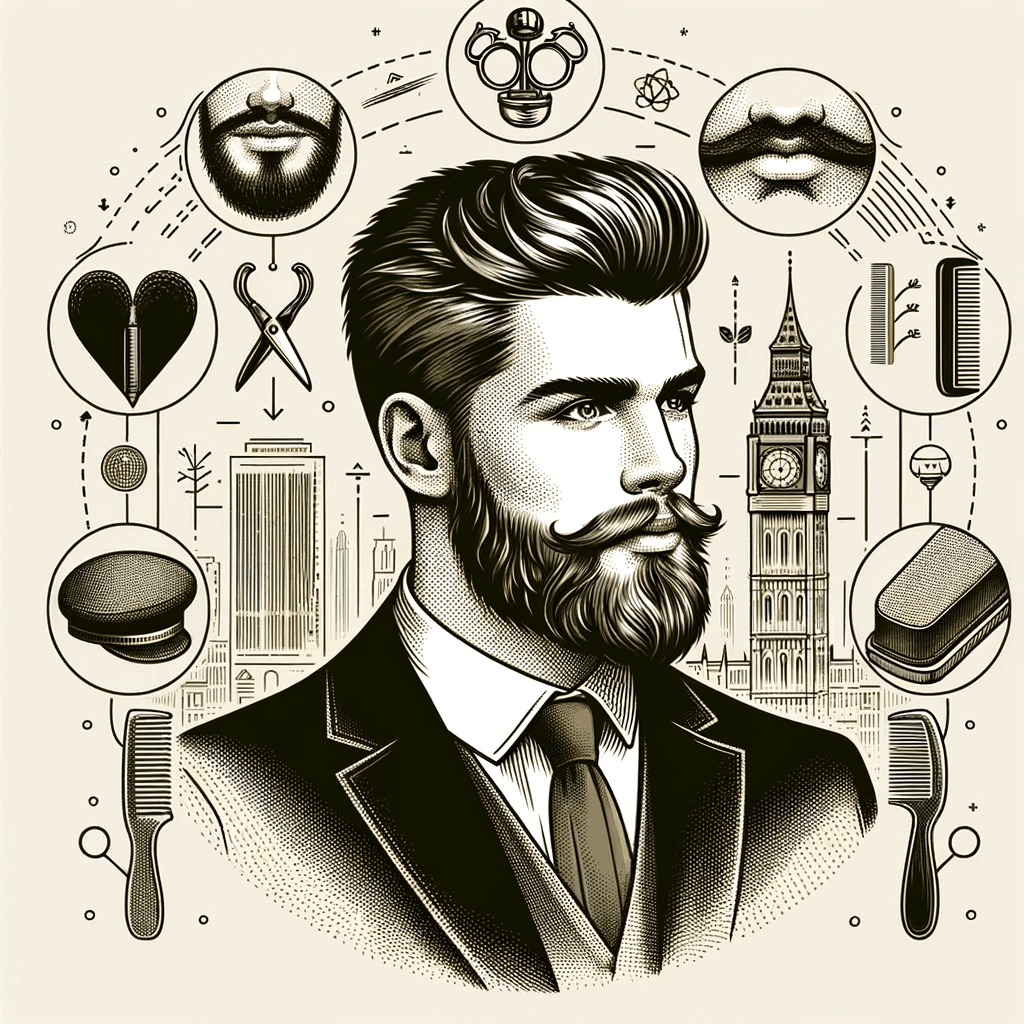
A Brief History of Beard Styles
The history of beard styles is as old as civilization itself. Throughout history, beards have been associated with wisdom, virility, and power. In ancient civilizations like Egypt, Greece, and Rome, beards were often groomed in specific styles that denoted status and profession. During the Middle Ages, beards were mostly worn by knights and warriors as a sign of ruggedness and bravery. The Renaissance era saw a decline in beard popularity, with a preference for a clean-shaven look among the European elite. However, the 19th century brought back the beard, symbolizing rebellion and a break from traditional norms.
In modern times, beards have become a canvas for personal expression. The 21st century has seen a wide variety of beard styles, from the carefully sculpted stubble to the full, bushy beard. Each style reflects not just personal taste but also the cultural and fashion trends of the time.
Cultural Significance of Beards
Beards also hold significant cultural and religious importance in many societies. For example, in some religions, beards are considered a sign of faith and devotion. In others, they are a rite of passage, marking the transition from boyhood to manhood. In contemporary culture, beards are often seen as a sign of rugged individualism and non-conformity.
The resurgence of beard popularity has also led to the growth of a vast grooming industry, dedicated to beard care products and services. This highlights the importance of understanding the basics of beard maintenance and grooming, which not only ensures a neat appearance but also promotes beard health.
In the following sections, we will delve into the various aspects of beard care, from understanding your beard type to grooming and styling, ensuring that your beard not only looks great but also feels comfortable and healthy.
Understanding Your Beard Type
Identifying Your Beard Type
Just as hair on your head varies from person to person, so do beard types. Understanding your beard type is essential in choosing the right care and styling methods. Generally, beard hair can be categorized into four main types: straight, wavy, curly, and coiled/kinky.
- Straight Beards: This type is the most manageable, but it can sometimes look less full. It's prone to becoming oily and requires regular washing.
- Wavy Beards: A common type that offers a balance between manageability and fullness. Wavy beards can sometimes become unruly and may require more styling to maintain shape.
- Curly Beards: These beards are often very full and thick. However, they can become tangled and are prone to dryness. Extra care is needed to keep them moisturized.
- Coiled/Kinky Beards: This type is the most prone to dryness and shrinkage, requiring constant hydration and careful grooming to prevent breakage.
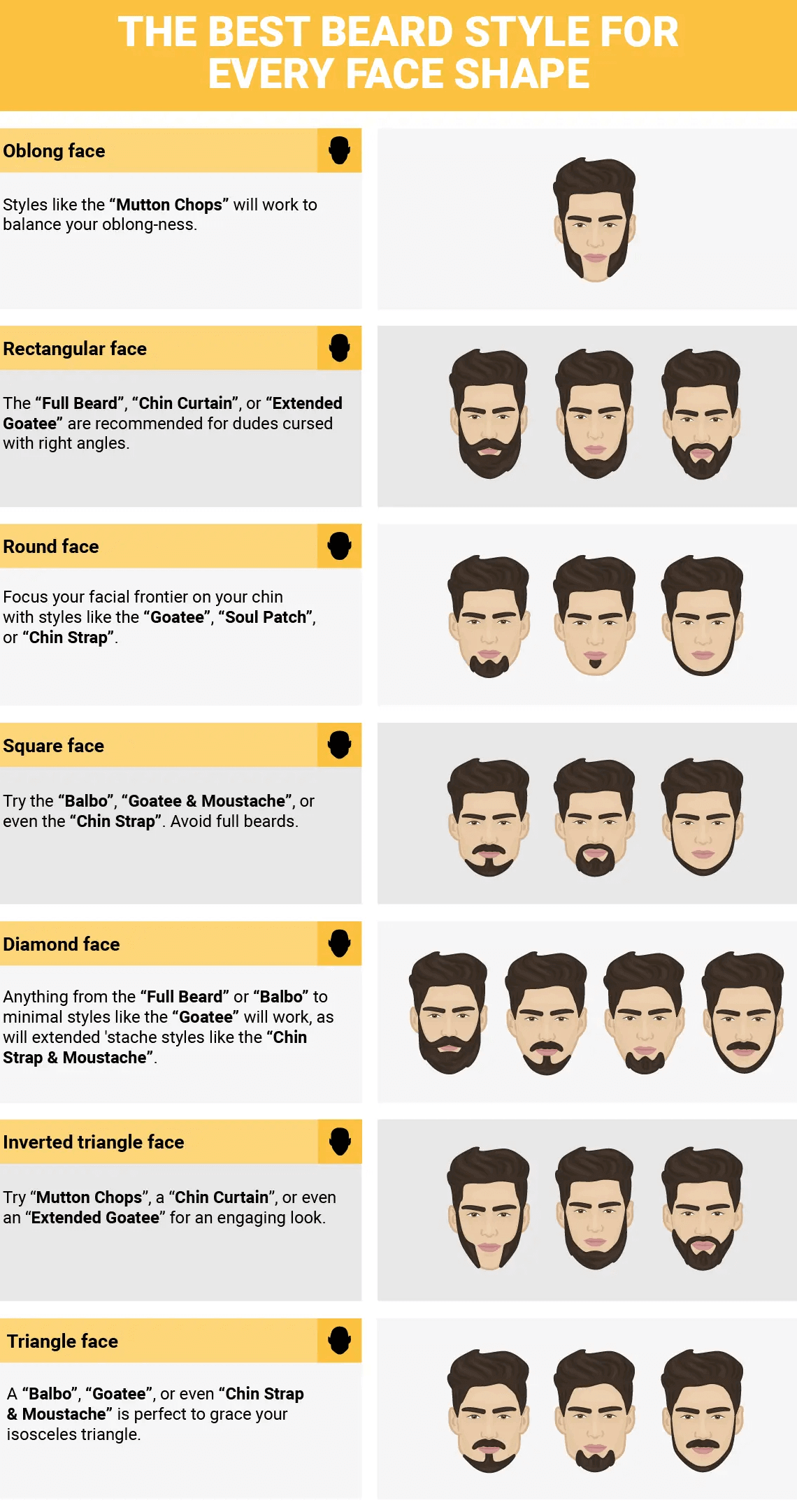
Customizing Your Care Routine
Once you’ve identified your beard type, you can tailor your grooming routine to suit its specific needs. For instance, straight and wavy beards might need more frequent washing but less oil, while curly and kinky beards require more hydration and less frequent washing to maintain moisture.
Genetics and Beard Growth
It's important to understand that genetics play a significant role in your beard's characteristics. Some men may find their beards grow in patchy or unevenly, which is often a genetic trait. While grooming can enhance the appearance of your beard, understanding and accepting your beard's natural growth pattern is key to setting realistic expectations for your beard care routine.
Environmental Factors
External factors like climate and pollution can also affect your beard. For example, a dry climate can make your beard more prone to breakage, while high humidity can cause frizz and unruliness. Adapting your grooming routine to your environment will help maintain the health and appearance of your beard.
In the next section, we will discuss the essential tools every bearded individual should have in their grooming kit, which are crucial for maintaining a healthy and well-groomed beard.
Essential Beard Care Tools
1. The Right Comb and Brush
A good comb and brush are indispensable for beard grooming. The type of comb you choose should depend on your beard's thickness and length:
- Fine-toothed Combs: Ideal for straight, shorter beards.
- Wide-toothed Combs: Better for curly or thicker beards.
- Boar Bristle Brush: Excellent for all beard types, especially for distributing oils evenly and stimulating the skin.
2. Beard Trimmers and Scissors
For maintaining the length and shape of your beard, trimmers and scissors are essential:
- Beard Trimmers: Useful for quick touch-ups and maintaining beard length. Look for one with various guard lengths.
- Scissors: Best for precise shaping and trimming stray hairs. Invest in a quality pair of barber scissors.
3. Beard Shampoo and Conditioner
Regular hair shampoo can be too harsh for your beard. Invest in a beard-specific shampoo and conditioner to keep your beard clean and soft:
- Beard Shampoo: Helps in gently cleansing the beard without stripping away natural oils.
- Beard Conditioner: Softens and hydrates the beard, making it easier to manage.
4. Beard Oils and Balms
Beard oils and balms are essential for moisturizing the skin underneath and keeping the beard soft:
- Beard Oil: Great for daily use, providing moisture and preventing beard itch.
- Beard Balm: Offers a hold for styling, along with moisturizing benefits.
5. Beard Care Kits
For beginners, a beard care kit can be a great starting point. These kits often include a combination of the above tools and products, tailored to different beard types and preferences.
Maintaining Your Tools
Proper maintenance of your tools is also important. Regularly clean and oil your scissors and trimmers. Brushes and combs should be washed to remove trapped hairs and skin cells.
The right tools not only make grooming easier but also ensure that you're taking the best possible care of your beard.
Washing and Conditioning the Beard
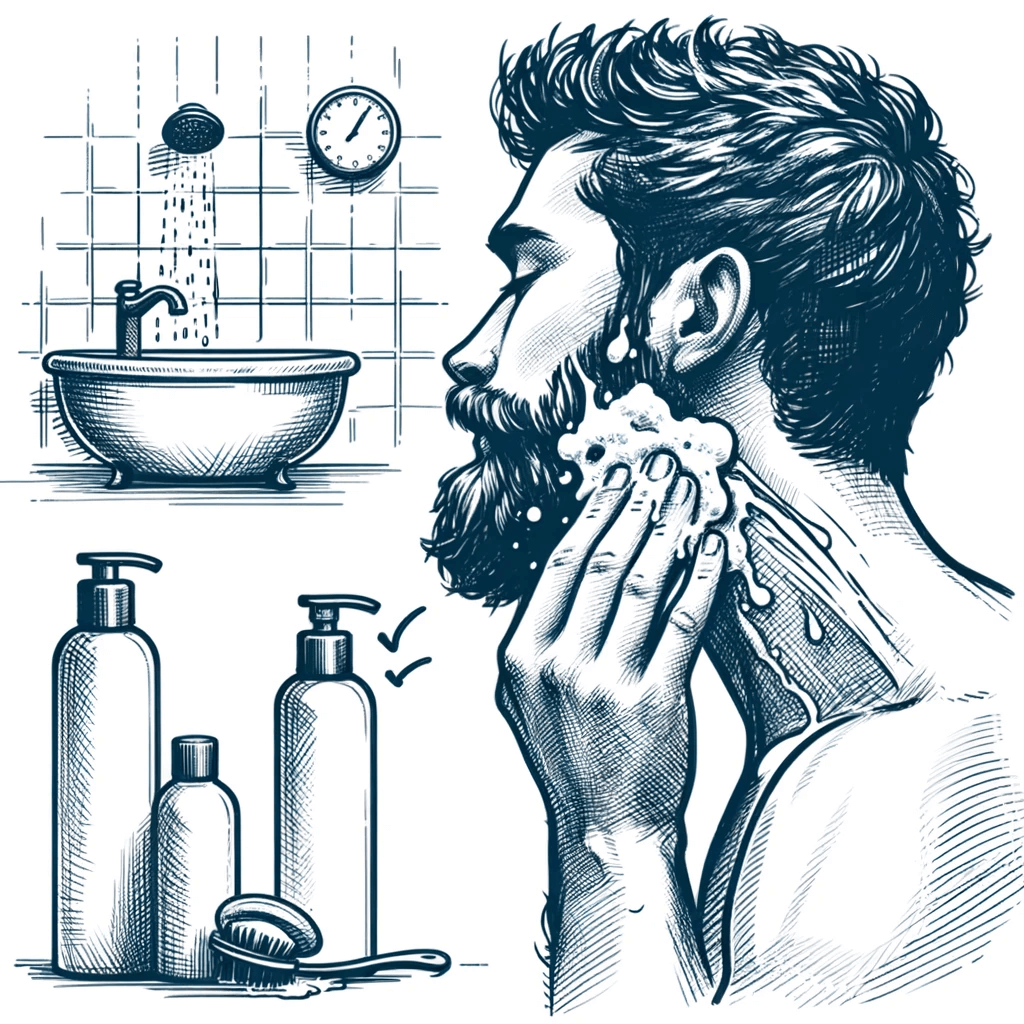
1. The Importance of Regular Washing
Regular washing is crucial for beard hygiene and health. It helps remove dirt, oil, and dead skin cells that can accumulate in your beard and cause issues like itching, dandruff, or even infections.
- Frequency: How often you should wash your beard depends on your beard type and lifestyle. Generally, washing 2-3 times a week is sufficient for most beard types.
2. Choosing the Right Products
Using the right products is key to maintaining a healthy beard:
- Beard-Specific Shampoos: Choose a gentle, beard-specific shampoo. These are formulated to clean without stripping away natural oils.
- Natural Alternatives: For a more natural approach, consider products with organic ingredients or even make your own beard wash with natural soaps.
3. Proper Washing Technique
- Wet Your Beard: Start with lukewarm water to open up the pores and soften the hair.
- Apply Shampoo: Use a small amount of beard shampoo, working it through your beard with your fingers.
- Rinse Thoroughly: Ensure all the shampoo is washed out to prevent residue build-up.
4. Conditioning Your Beard
After washing, a good beard conditioner helps to hydrate and soften the beard:
- Apply Conditioner: After shampooing, apply a beard conditioner, leaving it in for a couple of minutes.
- Rinse Out: Rinse thoroughly with cool water to close the pores and seal in moisture.
5. Drying Your Beard
- Pat Dry: Instead of rubbing, gently pat your beard with a towel to prevent frizz and damage.
- Avoid Heat: Excessive heat from blow dryers can dry out your beard. If necessary, use a blow dryer on a low heat setting.
6. The Role of Beard Oils and Balms After Washing
- Apply Beard Oil: Once your beard is dry, apply beard oil to moisturize the skin and hair.
- Use Beard Balm: For styling and additional hold, apply a small amount of beard balm.
Regular washing and conditioning are vital to maintaining a healthy, comfortable beard. It's about finding the right balance that works for your beard type and lifestyle.
Trimming and Shaping Your Beard

1. The Importance of Regular Trimming
Trimming is not just about maintaining the length; it's also essential for the overall health and appearance of your beard. Regular trims prevent split ends, promote even growth, and help in shaping your beard to enhance your facial features.
2. Tools for Trimming
- Beard Trimmers: Ideal for general length maintenance. Choose one with adjustable settings to cater to your desired length.
- Scissors: Precision tools for shaping and cutting stray hairs. Barber scissors are preferred for their sharpness and precision.
3. Techniques for Trimming
- Start with a Clean, Dry Beard: Trimming is best done when your beard is clean and dry, as wet hair is longer and can lead to uneven trimming.
- Use a Comb for Guidance: Comb through your beard to detangle and provide a guide for cutting.
- Trim in Small Increments: Trim small amounts at a time, checking symmetry as you go.
4. Shaping Your Beard
- Understand Your Face Shape: Different beard styles suit different face shapes. For example, a round face might benefit from a beard that is longer at the bottom to elongate the face.
- Define Neck and Cheek Lines: Properly defining these lines can greatly enhance the look of your beard. The neckline should typically be about an inch above your Adam's apple, while the cheek line should be natural but well-groomed.
5. DIY vs. Professional Grooming Services
While DIY grooming is cost-effective and convenient, professional services can offer a level of precision and expertise that might be challenging to achieve at home. For special occasions or if you're unsure about a style, consulting a professional barber can be beneficial.
6. Aftercare
- Hydrate and Soothe: After trimming, apply beard oil or balm to soothe the skin and keep the beard soft.
- Regular Maintenance: Establish a regular trimming routine to keep your beard in its ideal shape.
Trimming and shaping your beard is a skill that improves with practice. Understanding your beard type and facial structure, along with having the right tools, will enable you to maintain a well-groomed and stylish beard.
Beard Oils and Balms
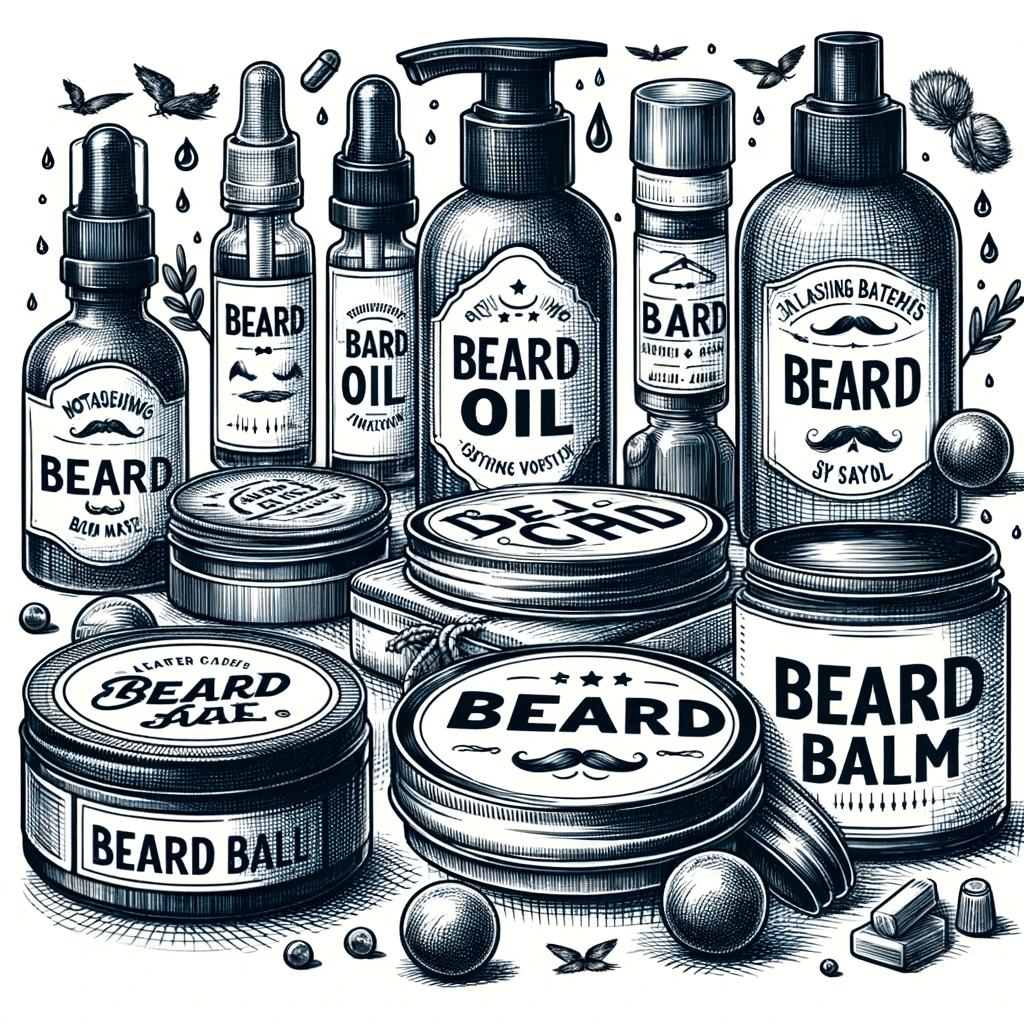
1. The Role of Beard Oils
Beard oil is a fundamental product for any beard care routine. It serves several functions:
- Moisturizing: Beard oil hydrates both the beard and the skin underneath, preventing dryness and flaking.
- Soothing: It helps to soothe irritation and itchiness, which are common in the early stages of beard growth.
- Nourishing: Quality beard oils contain vitamins and nutrients that promote healthy beard growth.
2. Choosing the Right Beard Oil
- Ingredients: Look for natural oils like jojoba, argan, and coconut oil. Avoid products with artificial fragrances or alcohol, as they can be drying.
- Scent: Beard oils come in various scents. Choose one that appeals to you and fits your style.
3. How to Apply Beard Oil
- Best Time: Apply after showering when your beard is clean and slightly damp.
- Amount: A few drops are usually enough, depending on the size of your beard.
- Technique: Rub the oil between your hands and gently work it through your beard, ensuring to reach the skin underneath.
4. The Benefits of Beard Balms
Beard balm, while similar to beard oil in moisturizing properties, provides additional benefits:
- Styling: It offers a light to medium hold, helping to tame flyaways and style your beard.
- Sealing in Moisture: Balms can lock in the moisture provided by the oil, keeping your beard conditioned for longer.
5. Choosing and Applying Beard Balm
- Ingredients: Look for natural butters like shea or cocoa butter and natural waxes for hold.
- Application: Use a small amount, warm it between your fingers, and apply it evenly through your beard.
6. Oil vs. Balm: Which to Use?
- Beard Length and Type: Shorter beards may benefit more from oil, while longer beards can use the extra hold and styling control provided by balms.
- Personal Preference: Some prefer the lightness of oil, while others like the control and added benefits of balm.
7. DIY Beard Care Products
For those interested in a more personalized approach, making your own beard oil or balm is a great option. It allows you to choose your own natural ingredients and scents.
Beard oils and balms are not just grooming products; they're essential tools for maintaining a healthy, comfortable, and stylish beard. They play a crucial role in your daily beard care routine.
Common Beard Problems and Solutions
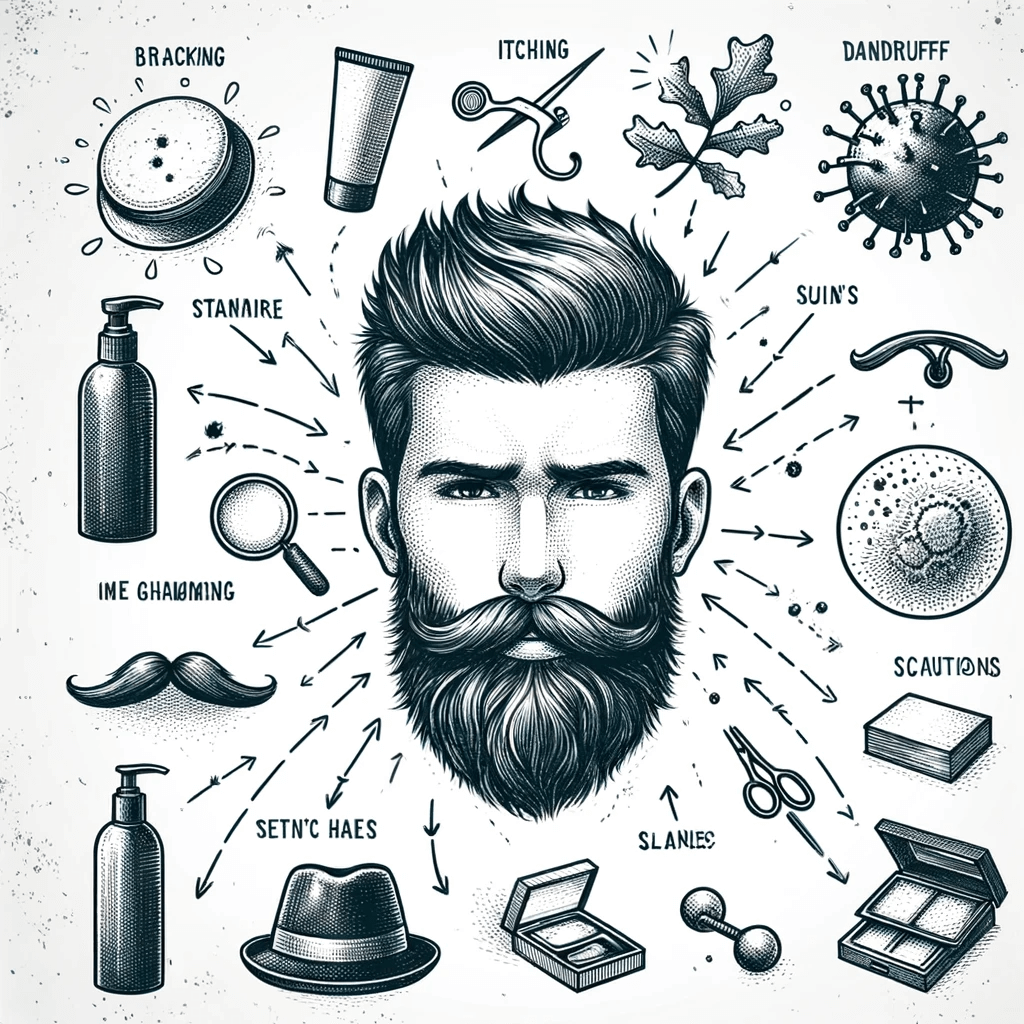
1. Itching and Irritation
One of the most common issues for those growing a beard, especially in the early stages, is itching and skin irritation.
- Causes: Often caused by dry skin, the growing process, or reaction to products.
- Solutions: Regular use of beard oil can help moisturize the skin. Gentle, natural soaps and shampoos are less likely to cause irritation. Also, ensure you’re not washing your beard too often.
2. Beard Dandruff (Beardruff)
Dandruff in the beard is a common issue that can be both uncomfortable and embarrassing.
- Causes: Usually due to dry skin under the beard.
- Solutions: Keep the skin under your beard moisturized with beard oil or balm. Hydrating and gentle cleansing are also essential.
3. Patchy Beard Growth
Many men experience uneven or patchy growth in their beards.
- Causes: Can be due to genetics, hormonal factors, or skin conditions.
- Solutions: Patience is key, as some areas may take longer to fill in. Beard styles can be adapted to cover patchy areas. In some cases, a healthy diet and good skincare can promote better growth.
4. Tangled and Unruly Beard
A long beard can become tangled and difficult to manage.
- Causes: Lack of grooming, dryness, or natural hair texture.
- Solutions: Regular brushing and combing, using a conditioner, and applying beard balm can help in managing a tangled beard.
5. Beard Acne
Acne under the beard can be painful and lead to poor beard growth.
- Causes: Clogged pores, often due to poor hygiene or build-up of grooming products.
- Solutions: Ensure thorough cleansing and rinsing of the beard. Use non-comedogenic oils and avoid heavy products that can clog pores.
6. Lifestyle Tips for a Healthier Beard
- Diet and Hydration: A balanced diet rich in vitamins and minerals, along with staying hydrated, can improve skin and hair health.
- Exercise: Regular exercise can improve blood circulation, which is beneficial for hair growth.
- Sleep: Adequate sleep is crucial for overall health, including beard health.
Addressing these common beard problems effectively can improve both the comfort and appearance of your beard. Understanding the causes and applying the right solutions can make a significant difference in your beard care routine.
Maintaining a Healthy Beard: Do's and Don'ts
-
1. Do's for Beard Health
- Do Keep It Clean: Regular washing with the right products is essential for keeping your beard free from dirt and bacteria.
- Do Moisturize: Use beard oils and balms to keep your beard and the skin underneath hydrated.
- Do Trim Regularly: Trimming your beard helps in getting rid of split ends and maintaining its shape.
- Do Eat a Balanced Diet: A diet rich in vitamins A, B, C, E, and F, as well as proteins and omega-3 fatty acids, can promote healthy hair growth.
- Do Stay Hydrated: Drinking plenty of water helps in hydrating the skin and hair.
- Do Exercise Regularly: Exercise increases blood flow, which aids in hair growth and health.
2. Don'ts for Beard Health
- Don’t Overwash: Overwashing can strip natural oils from your beard, leaving it dry and brittle.
- Don’t Neglect the Skin Underneath: The health of the skin under your beard is just as important as the beard itself.
- Don’t Use Harsh Chemicals: Avoid products with harsh chemicals that can damage beard hair and irritate the skin.
- Don’t Ignore Itching or Irritation: These could be signs of underlying skin issues that need to be addressed.
- Don’t Forget to Comb/Brush: Regular combing or brushing helps in distributing oils evenly and prevents tangling.
3. Lifestyle Factors Affecting Beard Health
- Stress: High stress levels can impact your beard's health, potentially leading to hair loss.
- Smoking: Smoking can restrict blood flow to hair follicles, hindering growth and health.
- Alcohol: Excessive alcohol consumption can lead to dehydration, affecting beard health.
4. Regular Checkups
- Dermatologist Visits: If you encounter persistent issues with your beard, such as severe itching, patchy growth, or hair loss, consider consulting a dermatologist.
Maintaining a healthy beard is not just about external care; it's also about a healthy lifestyle and paying attention to what your beard and skin are telling you. A holistic approach to beard care can lead to a fuller, healthier, and more attractive beard.
Trends and Styles in Beard Grooming
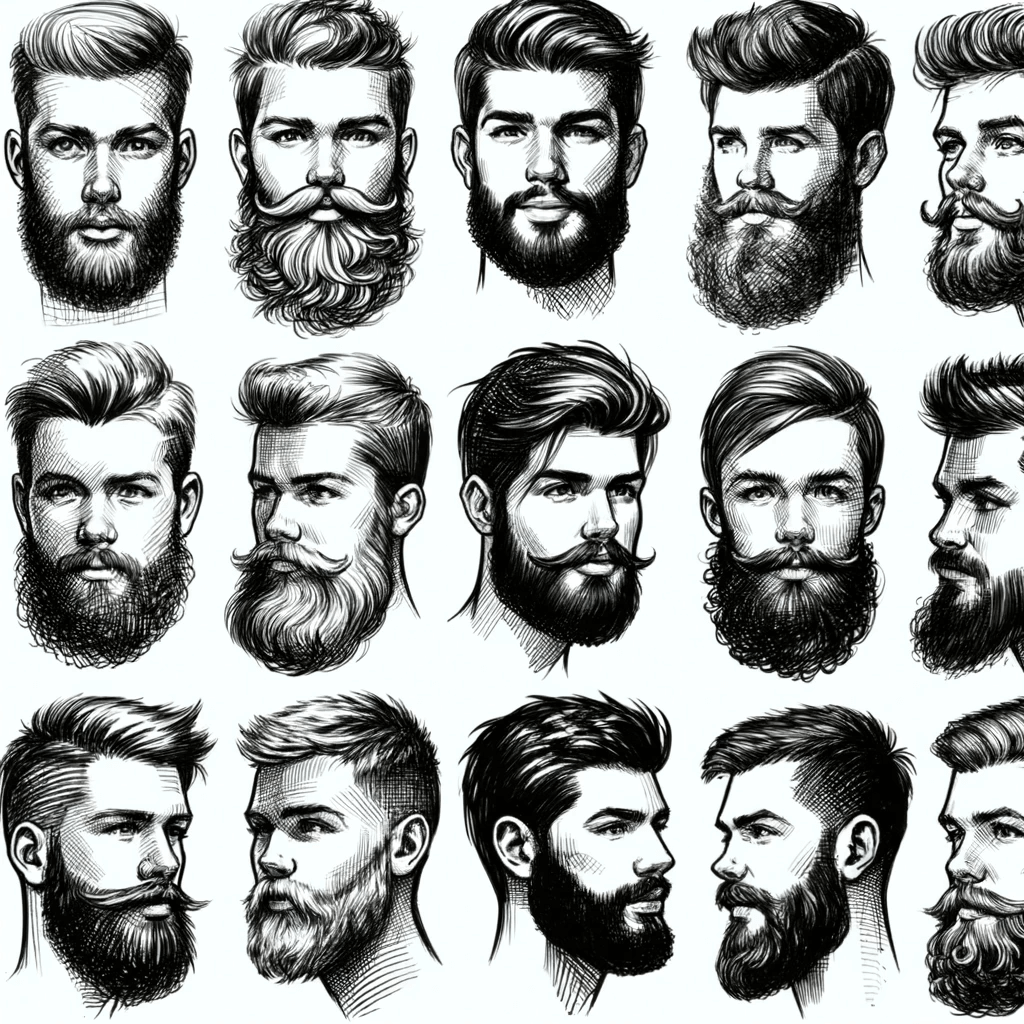
1. Keeping Up with Beard Trends
Beard styles, much like fashion, are constantly evolving. What's popular one year might change the next. Keeping an eye on current trends can inspire you to try new styles or update your current look.
- Classic Beard Styles
- The Full Beard: A timeless style that suits most face shapes. It requires regular maintenance for a neat appearance.
- The Goatee: A versatile style that can be adapted to different facial shapes.
- The Stubble: Popular for its low maintenance and rugged look. It ranges from light stubble to a heavy, more defined stubble.
3. Contemporary Trends
- The Balbo: Characterized by a disconnected mustache and beard, it’s a stylish choice for those who can grow a full beard.
- The Van Dyke: A combination of a pointed beard and a detached mustache, often styled with precision.
- The Bandholz: A long, full beard style popularized by beard enthusiasts, requiring patience and care to grow and maintain.
4. Choosing a Style That Suits You
- Consider Your Face Shape: Different beard styles complement different face shapes. For instance, a square jawline can be softened with a fuller beard.
- Think About Maintenance: How much time are you willing to invest in grooming? Some styles require more upkeep than others.
- Personal Style and Profession: Your beard should complement your personal style and be appropriate for your profession.
5. Experimentation and Personal Expression
Your beard is a form of personal expression. Don’t be afraid to experiment with different styles to find what truly suits you.
6. The Role of Grooming Products
- Styling Products: Products like beard wax and balm can help in styling and maintaining the shape of your beard.
- Color Enhancing Products: For those interested, there are products available to color or enhance the natural hue of your beard.
7. Consulting with a Professional Barber
For those new to beard grooming or looking to change their style, a consultation with a professional barber can provide valuable insights and recommendations.
Beard grooming is an art and a form of personal expression. Embracing current trends while considering your unique facial structure, lifestyle, and personal style is key to finding the perfect beard style for you.
Conclusion
Recap of Key Points
In this guide, we've explored the essential aspects of beard care, starting from understanding the importance of beard grooming and its historical and cultural significance. We've covered:
- Understanding Your Beard Type: Identifying the nature of your beard to tailor your care routine.
- Essential Beard Care Tools: The importance of having the right tools like combs, trimmers, and grooming products.
- Washing and Conditioning: The significance of using the right techniques and products for washing and conditioning your beard.
- Trimming and Shaping: Guidelines for regular trimming and shaping to maintain the health and appearance of your beard.
- Beard Oils and Balms: The necessity of using oils and balms for hydration and styling.
- Common Beard Problems: Solutions to tackle issues like itching, dandruff, and patchy growth.
- Maintaining a Healthy Beard: The do's and don'ts that encompass not just grooming practices but also lifestyle choices.
- Trends and Styles: Keeping up with the latest trends and understanding how to choose a style that suits you.
The Importance of a Regular Beard Care Routine
Developing and maintaining a regular beard care routine is crucial. It not only ensures that your beard looks great but also keeps it healthy. Regular grooming and proper care can prevent common beard problems and make your beard grooming experience enjoyable.
Encouragement for Continued Beard Care
We encourage you to keep experimenting with different styles and products to find what works best for you. Remember, beard grooming is not just about appearances; it's about self-care and expressing your individuality.
Further Resources
For more information and inspiration, consider following beard grooming forums, blogs, and social media channels. Books and guides on beard care can also provide deeper insights into the art of beard grooming.
Final Thoughts
Beard grooming is an art form that reflects personal style and requires dedication. With the right knowledge, tools, and care, your beard can be a source of pride and a key aspect of your personal expression.
Remember! You can always consult a professional barber at your nearest barbershop and make your beard perfect.

Post a Comment